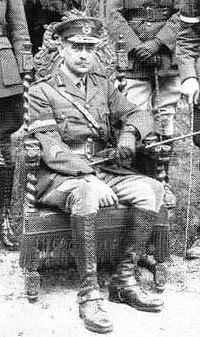16 May 1915
ANZAC - The low-key but deadly fighting at Anzac generated a continuous aural backdrop to their existence that could vary from the simple crack of a passing bullet to a veritable cacophony. Colonel Monash left an evocative description in a letter home.
 Photograph: Lieutenant Colonel John Monash, Headquarters, 4th Australian Brigade, NZ&A Division, AIF.
Photograph: Lieutenant Colonel John Monash, Headquarters, 4th Australian Brigade, NZ&A Division, AIF.
"The bullet which passes well overhead, especially if fired from a long range, has a sharp sudden crack like a whip, and really feels as if it is very close. Our own rifle fire, listened to from behind the firing-line sounds like a low rumble or growl. Our machine guns are exactly like the rattle of a kettledrum. The enemy's rifle and machine gun fire, on the other hand, sounds as if it were directly overhead, in a medley of sharp cracks like the explosions of packets of crackers just overhead, even though the fire is actually coming from the front, a half-mile away. The enemy's shrapnel sounds like a gust of wind in a wintry gale, swishing through the air and ending in a loud bang and a cloud of smoke, when the shell bursts. Unless one gets in the way of the actual fragments of the shell itself, the Turkish shrapnel does very little harm. Our own artillery is the noisiest of all, both the discharge of the guns and the bursting of the shells being ear-splitting, with a reverberating echo that lasts 20 or 30 seconds. We have been amusing ourselves by trying to discover the longest period of absolute quiet. We have been fighting now continuously for 22 days, all day and all night, and most of us think that absolutely the longest period during which there was absolutely no sound of gun or rifle fire, throughout the whole of that time, was 10 seconds. One man says he was able on one occasion to count 14, but nobody believes him!" (Lieutenant Colonel John Monash, Headquarters, 4th Australian Brigade, NZ&A Division).
"SOURCE:
J. Monash quoted by F. M. Cutlack, War Letters of General Monash (Australia: Angus & Robertson Ltd, 1934), pp.35-36
